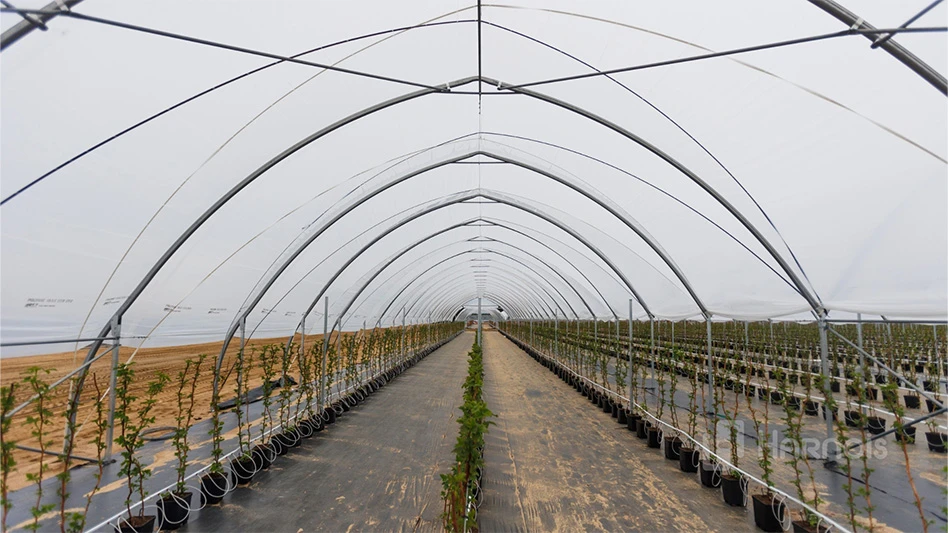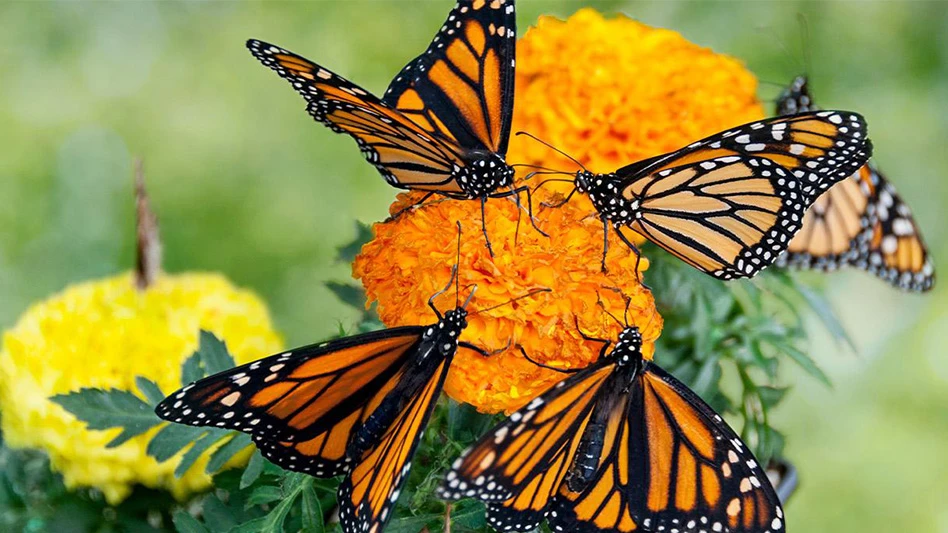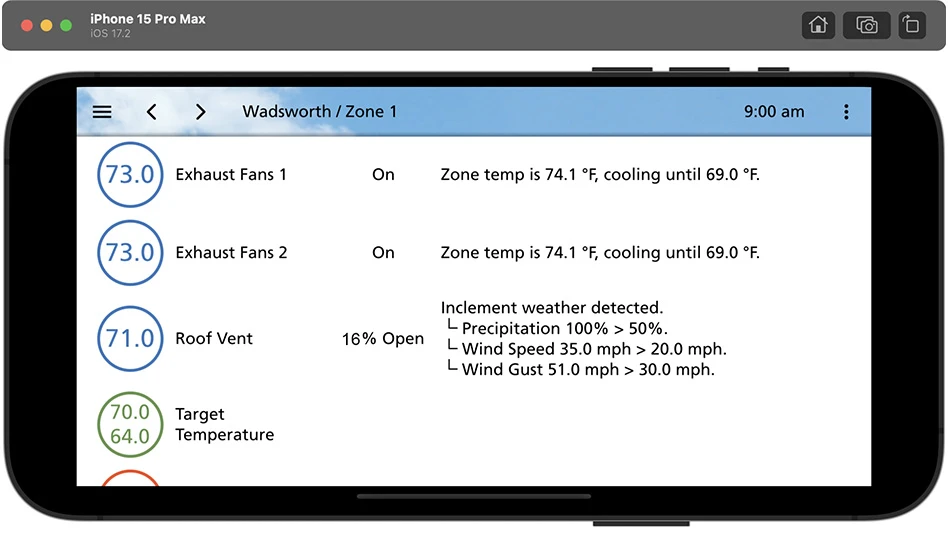 USDA-Agricultural Research Service and the Horticultural Research Institute scientists are working to develop feather-derived plastic that could be used to make growing containers. Photo by Stephen AusmusFeathers Could be Part of Biodegradable Pots USDA-Agricultural Research Service and the Horticultural Research Institute scientists are working to develop feather-derived plastic that could be used to make growing containers. Photo by Stephen AusmusFeathers Could be Part of Biodegradable PotsAbout 4 billion pounds of chicken feathers are generated by the poultry industry each year. Researchers at USDA-Agricultural Research Service and the Horticultural Research Institute have been collaborating on a project to formulate growing containers using feathers. The containers, which contain no petroleum components, would degrade over a variable amount of time from one to five years. ARS scientists have developed feather fiber which has numerous uses including air and water filtration and as a component of feather-derived plastic, which has properties similar to commercial polyethylene and polypropylene. The goal of the ARS and HRI researchers is to develop biodegradable keratin-based resins that can be used by container manufacturers to produce sustainable alternatives to petroleum-based growing containers. The scientists are also conducting biodegradability and composting trials to meet ASTM standards for bioplastics. In October, HRI filed a joint HRI/USDA-ARS patent application in support of their collaborative research efforts to develop degradable plastic resins. The Biodegradable Products from Poultry Feathers and Methods of Preparation Thereof patent is based on research done by HRI and USDA-ARS scientists. Preliminary discussions are underway with interested plastic resin compounders to license the keratin-based formulations. A commercial production run of 300-500 1-gallon containers is planned for January 2010. The containers will be distributed for evaluation to cooperating nursery and greenhouse growers, who are members of American Nursery & Landscape Association/HRI, and to three USDA-ARS research facilities. For more: Walter Schmidt, USDA-Agricultural Research Service, Environmental Management and Byproduct Utilization Laboratory, (301) 504-6765; www.ars.usda.gov. Marc Teffeau, American Nursery & Landscape Association, (202) 741-4855; mteffeau@anla.org; www.anla.org. |
Consumers are becoming increasingly aware of the amount of garbage that they produce. Consequently, manufacturers are looking for ways to reduce the amount of waste their products create for consumers. One of the ways that container manufacturers in the horticulture industry are working to reduce waste is to develop pots that do not have to be discarded in landfills once consumers are finished with them.
Degradable pots, or pots that can be broken down into smaller amounts, have been on the market for many years and fill these needs effectively. There are benefits and disadvantages to each, so it can be difficult choosing which one is the best for growers as well as their retail customers and the end consumer.
Reducing waste in trials
As part of Ohio State University’s effort to reduce waste, it was decided that a small, applied study using degradable containers would be conducted in conjunction with the annual plant trials program. The purpose was to evaluate these containers effectiveness in replacing the plastic containers that were traditionally used for the trials. The primary goals of the container trial were:
- To reduce the use of plastic containers in order to eliminate waste and to reduce the time needed to collect, clean, sanitize and reuse the pots.
- To evaluate the economic viability of the various degradable pots as compared to traditional plastic pots.
- To find an alternative pot that accomplishes these goals without sacrificing plant quality or survivability following transplanting into the ground.
Comparing degradable pots
Five different pots were used in the trial: Jiffy pots, Jiffy pellets, Cow Pots, Ellepots and a traditional plastic pot. The closest approximate sizes were used for replacing a standard 4-inch square plastic pot.
Jiffy pots are an OMRI-certified pot constructed of compressed peat. The Jiffy 4-inch round pot has been on the market for decades and was the most economically cost effective pot in this trial.
Jiffy pellets have been a staple of grower propagators, retail nurseries and the home garden market. With the introduction of a larger (72 mm) pellet and its fully biodegradable netting, the Jiffy 7 plug is a viable option for finished sizes for retail and landscape installations.
Cow Pots are 4-inch square pots that are an environmentally sustainable option that takes bovine bio-solids, a waste product, and turns them into a consumer product. Ellepots are very popular for propagation and have been increased in size (80 mm diameter) to provide an alternative to plastic pots.
The control container was a 4-inch square Dillen plastic pot that has been used to grow the plants for the summer annual trials since its inception in 2001.
Comparing the costs (July 2009 pricing in central Ohio) between the standard 4-inch plastic and degradable pots: Ellepots were 160 percent higher, CowPots were 20 percent higher and Jiffy pots were 4 percent lower. Jiffy 7 pellets were a new product and a price comparison was unavailable.
Plant trial evaluations
‘Angelface White’ angelonia, ‘Purple Flash’ ornamental pepper and ‘Amigo Red’ celosia were used in the trial. During week 17 several repetitions were transplanted from plugs or rooted liners, grown in the greenhouse at 74°F days, 68°F nights using the company-recommended production regime, and then transplanted into the ground during week 24.
 Since its inception in 1998, the Missouri Botanical Garden's Plastic Pot Recycling program has kept over 800,000 pounds of plastic waste out of landfills.Botanic Garden Keeps Horticultural Waste Out of Landfills Since its inception in 1998, the Missouri Botanical Garden's Plastic Pot Recycling program has kept over 800,000 pounds of plastic waste out of landfills.Botanic Garden Keeps Horticultural Waste Out of LandfillsSince 1998 the Missouri Botanical Garden has processed over 800,000 pounds (400 tons) of plastic pots, cell packs and trays through its Plastic Pot Recycling program. In 2009 130,000 pounds of horticultural waste was handled. The garden serves as a central collection site, open daily from late April through September. Ten retail garden centers throughout the metro St. Louis area participate in the environmental efforts as satellite collection sites. Also contributing to the collection are horticultural businesses, including landscape contractors, public works departments, grounds management professionals and wholesale growers. The plastic is granulated on-site into small chips that are easily transported for recycling. Through a cooperative agreement with Plastic Lumber Company of America, plastic lumber is being manufactured from the regrind and sold back to consumers for use in landscaping projects. Proceeds from the sale of the plastic timber is used to offset some of the costs of future collections. Grants from the St. Louis-Jefferson Solid Waste Management District, Missouri Department of Natural Resources, Missouri Environmental Improvement and Energy Resource Authority and Monrovia Growers also support the program. This year the garden plans to enhance the recycling program by expanding the fleet of recycling trailers to additional nursery and garden centers and making satellite collection locations more convenient to gardeners in city and metro areas. Also in 2010, program organizers will continue working with the horticulture industry in Kansas City to consider development of a similar recycling site that will offer seasonal container recycling to the public and businesses similar to the efforts in St. Louis. For more: Missouri Botanical Garden, (314) 577-9441; www.plasticpotrecycling.org. |
Plants were evaluated in the greenhouse and rated on a scale of 1 to 5 (5 being the most vigorous, 1 being the least vigorous). The evaluations were made twice, midway through production cycle during week 20 and again at transplanting outdoors in week 24.
All leaf, floral and stem tissue was collected, dried, and weighed during week 31. The dry weight analysis was expected to reflect plant vigor following transplant into outdoor beds.
Following harvesting, the root balls were removed and evaluated for pot degradation and root emergence. Evaluations were made on a scale of 1-5, with the plants with the higher score expected to be an indicator of the relative speed that plants were able to become established following transplanting.
Growth differences
As the trial progressed, some growth differences in the various pots were observed. A difference in the growth of celosia, based on pot composition, was seen during week 24 (seven weeks after transplanting), but not during week 20 (three weeks after transplanting). Cow pots showed flower development earlier and decomposed the fastest in the ground. Plants in the Jiffy plugs and Ellepots produced roots that reached the sides of the containers first and produced plants of equal or improved quality when compared with the plastic pots. Jiffy pots rooted strongly from the drainage holes and any holes created by mechanical means.
Overall, all of the pots performed well and would make suitable substitutes for plastic pots. Based on observations, only the Cow Pots appeared to be biologically degrading in the soil seven weeks after being transplanted into the ground. Most of the pots were mechanically degraded by plant/root growth. More time should be allowed to determine the extent of long term biological degradation.
Container differences
Based on the observation made during the study:
- Biologically degradable containers are a viable alternative to plastic for direct planting.
- Container rigidity, bench life and shelf life are issues that need to be considered when selecting a container.
- Mechanical breakdown of these containers is the primary method for decomposition, followed by biological degradation.
- Cow Pots seem to impart an added degree of fertility, but not until roots reach the sides of the pot.
- Smaller soil volume in the containers led to more rapid root emergence and expansion. Aerial root pruning in the degradable pots seems to hasten establishment after transplanting in outdoor beds compared to a plastic pot.
The key to picking a degradable pot is to balance how easily it fits into your current production operation (potting and transplanting machines/lines, shuttle trays, bench space, etc.). Does the container suit your personal aesthetic (morally and visually), and if it improves the product for your end customer, either by giving a superior plant, improving plant installation and survivability, or by reducing the waste produced by gardening.
For additional conclusions, results and photos, visit http://floriculture.osu.edu. Additional research is being conducted to determine root establishment following transplant and to evaluate the durability and longevity of the degradable pots on the bench.
Bart Hayes is annual trial manager and greenhouse coordinator, Ohio State University, (614) 292-3319; hayes.238@osu.edu.

Explore the January 2010 Issue
Check out more from this issue and find your next story to read.
Latest from Greenhouse Management
- Star Roses and Plants introduces Martha Stewart Rose
- Hoffman Nursery announces David Hoffman as CEO, Craig Reynolds as COO
- Plantpeddler releases Poinsettia Variety Day 2024 results
- Sarisa insecticide now registered for drench applications and many common greenhouse vegetable crops
- Ball FloraPlant launches redesigned website
- Costa Farms wins Top 10 Marketing Team at 2024 OnCon Icon Awards
- Thank you(!)
- Construction begins at Dramm’s Fish Fertilizer Facility in Wisconsin





